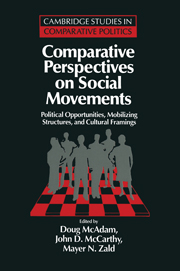 Comparative Perspectives on Social Movements
Comparative Perspectives on Social Movements Book contents
- Frontmatter
- Contents
- Biographical sketches of contributors
- Preface
- Introduction: Opportunities, mobilizing structures, and framing processes – toward a synthetic, comparative perspective on social movements
- PART I POLITICAL OPPORTUNITIES
- PART II MOBILIZING STRUCTURES
- PART III FRAMING PROCESSES
- 11 Culture, ideology, and strategic framing
- 12 Framing political opportunity
- 13 Accessing public, media, electoral, and governmental agendas
- 14 Media discourse, movement publicity, and the generation of collective action frames: Theoretical and empirical exercises in meaning construction
- 15 The framing function of movement tactics: Strategic dramaturgy in the American civil rights movement
- Notes
- References
- Index
14 - Media discourse, movement publicity, and the generation of collective action frames: Theoretical and empirical exercises in meaning construction
Published online by Cambridge University Press: 05 June 2012
- Frontmatter
- Contents
- Biographical sketches of contributors
- Preface
- Introduction: Opportunities, mobilizing structures, and framing processes – toward a synthetic, comparative perspective on social movements
- PART I POLITICAL OPPORTUNITIES
- PART II MOBILIZING STRUCTURES
- PART III FRAMING PROCESSES
- 11 Culture, ideology, and strategic framing
- 12 Framing political opportunity
- 13 Accessing public, media, electoral, and governmental agendas
- 14 Media discourse, movement publicity, and the generation of collective action frames: Theoretical and empirical exercises in meaning construction
- 15 The framing function of movement tactics: Strategic dramaturgy in the American civil rights movement
- Notes
- References
- Index
Summary
The Netherlands has the reputation of having one of the best social security systems in the world. Part of this system is the Disability Insurance Act (WAO). It rules that everybody who is physically incapable of continuing to work on his or her own level of education and work experience is entitled to a benefit of 70 percent of his or her last-earned income.
Since 1968, the year the Disability Insurance Act was implemented, work disability in the Netherlands has grown at an epidemic rate. At the time of the Act's conception it was projected that the number of people receiving a disability allowance (DA) would never exceed 200,000. But the number of people on a disability allowance (DA) rose from 160,000 in 1968 to 900,000 in the early 1990s. The “disease of worker disability” is potent only in the Netherlands. In comparable countries such as West Germany, the United States, and Sweden the number of recipients of disability benefits per 1,000 members of the labor force remained fairly stable over a 20-year period from 1970 through 1989 (oscillating around 55 in West Germany, 40 in the United States, and 70 in Sweden). In that same period figures rose in the Netherlands from 55 in 1970 to 152 in 1989 – an increase of almost 300 percent (Burkhauser 1991).
With 900,000 persons on DA, an estimated 21 billion guilders per year, or 6 percent of the country's gross national product, is spent on disability allowances (as compared to 2.3 percent in France and 3.5 percent in West Germany).
- Type
- Chapter
- Information
- Comparative Perspectives on Social MovementsPolitical Opportunities, Mobilizing Structures, and Cultural Framings, pp. 312 - 337Publisher: Cambridge University PressPrint publication year: 1996
- 26
- Cited by


